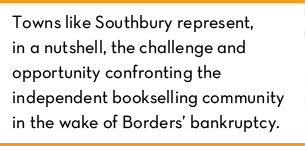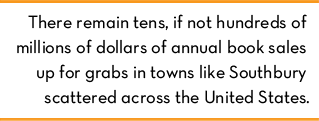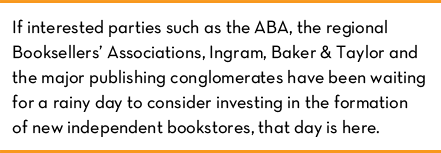By Jack McKeown and Don Linn
“Borders ended up caught between the variety of the Internet and the intimacy of the independents. Its outlets could never stock as many books as Amazon. Nor could they duplicate the native flavor of the corner bookstores…As paper books become a niche product, niche retailers will be the best place to buy and sell them.” —Edward McClelland, “How Borders Lost its Soul,” Salon.com, February 19, 2011
Southbury is a town located in western Connecticut, part of a region known as the Central Naugatuck Valley. It is a town with both rural and suburban neighborhoods, and a charming historic district. With its four-largest neighboring towns, it comprises a book market of approximately 175,000 souls whose demographics skew to relatively affluent, highly educated and older, propelled by an influx of Baby Boomer empty-nesters and retirees over the last ten years. Two weeks ago, Southbury lost it sole surviving bookstore—a 22,000 square-foot Borders in Southbury Plaza, one of the two hundred superstores closed throughout the country as a part of the chain’s bankruptcy. The nearest Barnes & Noble is in Danbury, 22 miles away. The nearest independents are in Ridgefield and Washington, 20-to-25 miles distant—too far for a casual shopping trip. Without an enterprising independent stepping in to fill this vacuum, who could blame Southbury’s population for falling into the waiting arms of Amazon as the only viable alternative?
 Towns like Southbury represent, in a nutshell, the challenge and opportunity confronting the independent bookselling community in the wake of Borders’ bankruptcy. Suddenly there will be hundreds of sustainable, niche markets with no bookstore presence—a dramatic “supply gap” of physical bookstores of a scale that has not existed for forty years. A tectonic shift of the bricks-and-mortar retail landscape is upon us, whether we are ready for it or not. Not since the explosion of the mall stores in the 1970s, the chain superstores and big-box retail in the late 1980s, and the disruptive emergence of Amazon in the late 1990s, have we seen change of this magnitude and speed. Independent bookstores are about to face a critical test in the next couple of years, and how they respond to this emerging supply gap will determine not only their long-term future, but possibly the fate of the printed book as well.
Towns like Southbury represent, in a nutshell, the challenge and opportunity confronting the independent bookselling community in the wake of Borders’ bankruptcy. Suddenly there will be hundreds of sustainable, niche markets with no bookstore presence—a dramatic “supply gap” of physical bookstores of a scale that has not existed for forty years. A tectonic shift of the bricks-and-mortar retail landscape is upon us, whether we are ready for it or not. Not since the explosion of the mall stores in the 1970s, the chain superstores and big-box retail in the late 1980s, and the disruptive emergence of Amazon in the late 1990s, have we seen change of this magnitude and speed. Independent bookstores are about to face a critical test in the next couple of years, and how they respond to this emerging supply gap will determine not only their long-term future, but possibly the fate of the printed book as well.
The digi-catastrophists predict, now that we have reached 8-10% e-book penetration, that chain bookstores and independents alike are condemned to the same oblivion. That argument ignores a central truth: the chains and independents have evolved to present nearly antithetical shopping experiences. As Edward McClelland notes above, where do you locate the competitive advantage in a 150,000-volume superstore relative to the endless storefront of the internet? Independent bookstores, on the other hand, with their focus on finely curated inventory, hand-selling, and a robust program of local events and community outreach, offer a shopping experience that dramatically differentiates them from their chain competition. The independents could be well positioned to move into niche markets abandoned by the chains, while simultaneously upping their game on the Internet with programs such as Google eBooks and the American Bookseller Association’s IndieCommerce web-hosting engine.
What will it take for independent bookstores to seize the opportunity? That is a question we have been pondering, in general terms, since long before the visible manifestation of Borders’ disarray two weeks ago. In November, 2009 Jack McKeown posted an article about the need for a special-purpose financing entity, a Neighborhood Bookstore Development Bank (NBDB), modeled after a similar initiative that has worked successfully for independent grocery stores. Its mission would be to spearhead the deployment of capital to a new generation of bookstore entrepreneurs, as well as existing booksellers looking to branch out or upgrade their spaces. We reprise one of the core arguments of that posting, as follows:
“A thriving neighborhood bookstore is recognized as a key element in the social, cultural and economic fabric of any community. This is an opinion widely shared by urban planners, government planning boards, Smart Growth advocates, landlords and real estate developers around the country…Primarily, it has been the national chains that have been the beneficiaries of this perception, and their superior access to capital is the fundamental reason why. But with the recession, chain store expansion has ground to a halt and a period of contraction almost certainly will follow…The NBDB could play a major role in changing the narrative on independent bookstores from one of decline to rebound.”
Before talking about raising new capital, we should estimate the dimension of the supply gap, measured in annual book sales. Borders’ sad situation presents opportunities for revitalization in many, but not all of the communities where stores will be closed. A cursory look at the initial list of two hundred superstore closings reveals that over half lie beyond a five-mile driving radius from their nearest indie competition. The average and mean distances are 13.2 miles and 10.7 miles respectively to the nearest independent. Most of these one hundred-plus sites are close-in suburbs, within commuting range of top urban markets. If we use a conservative suburban population density of 3,000 people per square mile [1], then we can estimate that about 15 million Americans will be directly affected by the sudden reduction in bookstore availability. In dollar terms, applying Borders’ average footprint of 25,000 square feet and sales-per-square-foot of @$170, then the supply gap for these one hundred towns exceeds $400 million. Again this does not take into account the remaining 100 initial closures, nor the rumored further 75-135 targeted for a second wave of liquidation. So, in reality, the potential gap nationwide is much larger and our estimates very conservative. If the Chapter 11 reorganization is not approved by creditors, or if it is unsuccessfully executed, then many more communities nationwide will be deprived of their nearest bricks-and-mortar bookstores as Borders proceeds to full liquidation. In that instance, the supply gap could approach $1 billion annually.
 Time may well be of the essence for the indies to take action. In an earnings call last week, Mitchell Klipper of B&N made reference to his chain’s eyeing several closed Borders locations. Later the same week, they announced a $40 million retooling of their marketing operations aimed at rejuvenating their brand and store appearance. It would appear that B&N intends to pursue this supply gap with some added investment, probably by cherry-picking those markets they previously shared with a Borders superstore. It would be in their interest to be opportunistic where there are vacuums to fill that make sense for them.
Time may well be of the essence for the indies to take action. In an earnings call last week, Mitchell Klipper of B&N made reference to his chain’s eyeing several closed Borders locations. Later the same week, they announced a $40 million retooling of their marketing operations aimed at rejuvenating their brand and store appearance. It would appear that B&N intends to pursue this supply gap with some added investment, probably by cherry-picking those markets they previously shared with a Borders superstore. It would be in their interest to be opportunistic where there are vacuums to fill that make sense for them.
Even if a substantial majority, say sixty percent, of the supply gap is captured by Amazon, B&N, or by a conversion to digital reading, there remain tens, if not hundreds of millions of dollars of annual book sales up for grabs in towns like Southbury scattered across the United States. Our own ongoing consumer research, conducted by Verso Digital, provides additional reason for optimism.  The data consistently point to a hybrid print and e-book market that will persist for decades. E-reader owners who classify as avid readers (ten or more books bought per year) are splitting their purchases between print and e-books in nearly identical numbers. Moreover, there is a sizable majority of readers, over 70%, who express strong resistance to the idea of screen-reading as a substitute for print, a percentage that has remained steady across multiple surveys over the past two years. The resistance is strongest among older (45-plus) readers, who already account for more than two-thirds of the consumer books purchased in this country. As these readers downshift into retirement or more flexible work-leisure lifestyles, their proportion of the book market is likely to increase, further making the case for print’s durability.
The data consistently point to a hybrid print and e-book market that will persist for decades. E-reader owners who classify as avid readers (ten or more books bought per year) are splitting their purchases between print and e-books in nearly identical numbers. Moreover, there is a sizable majority of readers, over 70%, who express strong resistance to the idea of screen-reading as a substitute for print, a percentage that has remained steady across multiple surveys over the past two years. The resistance is strongest among older (45-plus) readers, who already account for more than two-thirds of the consumer books purchased in this country. As these readers downshift into retirement or more flexible work-leisure lifestyles, their proportion of the book market is likely to increase, further making the case for print’s durability.
If interested parties such as the ABA, the regional Booksellers’ Associations, Ingram, Baker & Taylor and the major publishing conglomerates have been waiting for a rainy day to consider investing in the formation of new independent bookstores, that day is here.  Without a sufficient number of retail outlets for print books, we will see publishers devoting even more of their limited resources to digital formats, further accelerating store closures. A vicious cycle, but it does not have to be that way. In the NBDB example, $2.5 million of seed capital could be leveraged into $10 million in loan-able funds. That would be enough to jumpstart the development of 50 mid-sized independents. Within three years, a $40 million loan portfolio would support 200-plus new or revitalized stores.
Without a sufficient number of retail outlets for print books, we will see publishers devoting even more of their limited resources to digital formats, further accelerating store closures. A vicious cycle, but it does not have to be that way. In the NBDB example, $2.5 million of seed capital could be leveraged into $10 million in loan-able funds. That would be enough to jumpstart the development of 50 mid-sized independents. Within three years, a $40 million loan portfolio would support 200-plus new or revitalized stores.
The supply gap identified above provides a useful springboard for bookstore entrepreneurs looking to formulate convincing business plans, a prerequisite for any NBDB financing. The opportunities need to be examined location by location, of course, and there will be no one-size-fits-all solution. Relatively straightforward market analysis of demographics, traffic patterns, local retail demand and supply, etc. can help pinpoint the most desirable locations. The proposed stores need to be right-sized in order to reduce overhead, lower investment risk, and increase inventory turn-rates. As stressed in the original NBDB proposal, these business plans would be subjected to rigorous vetting by an independent commission of industry experts who operate at arm’s length from any of the bank’s investors.
Any NBDB loan would be accompanied by a clear plan for use of the proceeds, and realistic, enforceable repayment terms. NBDB officers regularly would monitor the borrowing stores to assure compliance and performance milestones against the original plan. While open to new bookstore models and experimentation, the NBDB would not lend to dilettantes who do not subscribe to the core best practices and values of independent bookselling, or who fail to present the necessary management track record. Here we detect a silver-lining, for the Borders’ closings provide a pool of experienced store managers, some of whom will have what it takes to step into the role of bookstore entrepreneur.
In some communities, existing Borders stores could be re-imagined for conversion to independent ownership, such as happened recently with two Walden stores in New England. One possibility would be for the new owners to partner with other, compatible businesses in dividing up these excessive superstore spaces. Landlords could be instrumental in enabling independent owners to obtain working-capital financing with local lenders. They also could provide appropriate tenant improvement (TI) allowances for upgrading their spaces. Let us remember that neighborhood bookstores represent a highly desirable community amenity that landlords and developers covet as traffic builders for their other retail tenants.
Government could play a part as well. While there has been more noise than actual funds flow, the Obama administration has been speaking out publicly, and often, about getting credit into the hands of small businesses. It may be possible to convince the Small Business Administration to fund or guarantee some portion of the NBDB’s credit flow. The political effort to make this happen would be significant and could only be accomplished if the NBDB’s investors closed ranks to present united, industry-wide support.
The NBDB concept is not particularly complex, but it does require a leap of faith and strong leadership at the national level. A sense of inertia and gloom persists among independent booksellers after decades of seeing their ranks erode under chain and Internet competition. We cannot allow this legacy to blind us to the unique possibilities created in the wake of Borders’ bankruptcy. In the months following the original publication of the NBDB article in late 2009, the authors have received some encouraging expressions of interest from potential investors.  They will be ramping up their personal efforts to promote the concept in the months leading up to BEA. Proceeding thoughtfully, but with a sense of commercial urgency, independent bookstores can take advantage of a unique opportunity to recapture market share and to remain relevant for decades to come, not just locally, but as a national force.
They will be ramping up their personal efforts to promote the concept in the months leading up to BEA. Proceeding thoughtfully, but with a sense of commercial urgency, independent bookstores can take advantage of a unique opportunity to recapture market share and to remain relevant for decades to come, not just locally, but as a national force.
Jack McKeown
Don Linn
[1] Francesca Pozzi and Christopher Small, Exploratory Analysis of Suburban Land Cover and Population Density in the U.S.A., Columbia University, New York, 2001.
